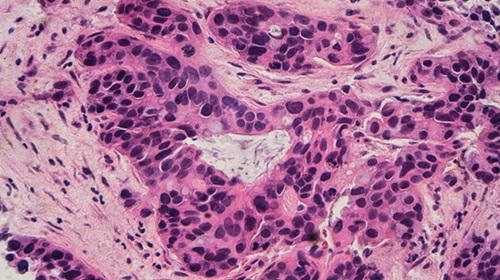Rapid Injection Technique Improves Production of Genetically Engineered Mice
|
By LabMedica International staff writers Posted on 06 Jun 2016 |
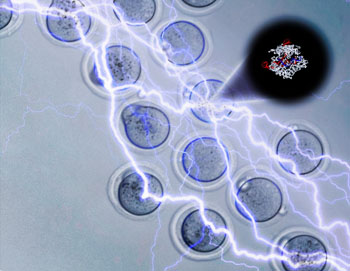
Image: Electroporation jolts embryos with electricity to open holes that allow the CRISPR-Cas9 molecule (lower right) to enter and edit the DNA (Photo courtesy of Dr. Andrew Modzelewski, Dr. Lin He, University of California, Berkeley).
An electroporation method has been introduced that improves the production of genetically altered "knock-out" mice by requiring less time and being more efficient at introducing the CRISPR-Cas9 genome editing complex than is the current microinjection method.
CRISPRs (clustered regularly interspaced short palindromic repeats) are segments of prokaryotic DNA containing short repetitions of base sequences. Each repetition is followed by short segments of "spacer DNA" from previous exposures to a bacterial virus or plasmid. CRISPRs are found in approximately 40% of sequenced bacteria genomes and 90% of sequenced archaea. CRISPRs are often associated with cas genes that code for proteins related to CRISPRs. The CRISPR/Cas complex comprises a prokaryotic immune system that confers resistance to foreign genetic elements such as plasmids and phages and provides a form of acquired immunity. Since 2013, the CRISPR/Cas system has been used in research for gene editing (adding, disrupting, or changing the sequence of specific genes) and gene regulation. By delivering the Cas9 protein and appropriate guide RNAs into a cell, the organism's genome can be cut at any desired location. The conventional CRISPR-Cas9 system is composed of two parts: the Cas9 enzyme, which cleaves the DNA molecule and specific RNA guides (CRISPRs) that shepherd the Cas9 protein to the target gene on a DNA strand.
CRISPR-mediated mouse genome editing is typically accomplished by microinjection of Cas9 DNA/RNA and single-guide RNA into zygotes to generate modified animals in one step. However, microinjection is a technically demanding, labor-intensive, and costly procedure with poor embryo viability. In practice, the microinjection method requires inoculation of individual cells or embryos with two RNA molecules - messenger RNA (mRNA), which codes for the Cas9 protein, and guide RNA, which provides the address for CRISPR-Cas9's target. In only a small percentage of cells the mRNA is properly translated into Cas9 protein, and the protein correctly combines with the guide RNA.
Electroporation relies on a burst of electricity to create holes in cells or embryos through which molecules can enter. Investigators at the University of California, Berkeley (USA) recently described a novel adaptation of the technique, which they called CRISPR-EZ (CRISPR RNP Electroporation of Zygotes). They described this simple and cost-effective methodology, which can be performed on many embryos at once and takes only milliseconds to perform in the May 5, 2016, online edition of the Journal of Biological Chemistry.
Using CRISPR-EZ, which could deliver Cas9/sgRNA ribonucleoproteins (RNPs) into mouse zygotes with 100% efficiency, the investigators generated a variety of editing schemes in mouse embryos, including indel (insertion/deletion) mutations, point mutations, large deletions, and small insertions. In a proof-of-principle experiment, they used CRISPR-EZ to target the Tyrosinase (Tyr) gene, achieving 88% bi-allelic editing and 42% Homology-Directed Repair (HDR)-mediated precise sequence modification in live mice.
"The key fundamental insights about the biological significance of a gene usually come from in vivo gene-editing studies, in which you generate mice with an altered gene," said senior author Dr. Lin He, a associate professor of molecular and cell biology at the University of California, Berkeley. "But it is a major commitment to make a novel knockout with genome engineering. I think this technology could greatly reduce the technical barrier for this type of effort and will allow people to focus more on the science rather than be consumed by the process of genetically engineering mice."
"The actual percentage of live births from injected embryos is around 10 to 15% for most transgenic facilities, which is a problem with the procedure," said Dr. He. "Sometimes people collect more than 100 embryos just to generate one or two mice with desirable gene editing. Electroporation appears to do less damage to the embryos than microinjection: between 30% and 50% of the embryos resulted in live births."
Related Links:
University of California, Berkeley
CRISPRs (clustered regularly interspaced short palindromic repeats) are segments of prokaryotic DNA containing short repetitions of base sequences. Each repetition is followed by short segments of "spacer DNA" from previous exposures to a bacterial virus or plasmid. CRISPRs are found in approximately 40% of sequenced bacteria genomes and 90% of sequenced archaea. CRISPRs are often associated with cas genes that code for proteins related to CRISPRs. The CRISPR/Cas complex comprises a prokaryotic immune system that confers resistance to foreign genetic elements such as plasmids and phages and provides a form of acquired immunity. Since 2013, the CRISPR/Cas system has been used in research for gene editing (adding, disrupting, or changing the sequence of specific genes) and gene regulation. By delivering the Cas9 protein and appropriate guide RNAs into a cell, the organism's genome can be cut at any desired location. The conventional CRISPR-Cas9 system is composed of two parts: the Cas9 enzyme, which cleaves the DNA molecule and specific RNA guides (CRISPRs) that shepherd the Cas9 protein to the target gene on a DNA strand.
CRISPR-mediated mouse genome editing is typically accomplished by microinjection of Cas9 DNA/RNA and single-guide RNA into zygotes to generate modified animals in one step. However, microinjection is a technically demanding, labor-intensive, and costly procedure with poor embryo viability. In practice, the microinjection method requires inoculation of individual cells or embryos with two RNA molecules - messenger RNA (mRNA), which codes for the Cas9 protein, and guide RNA, which provides the address for CRISPR-Cas9's target. In only a small percentage of cells the mRNA is properly translated into Cas9 protein, and the protein correctly combines with the guide RNA.
Electroporation relies on a burst of electricity to create holes in cells or embryos through which molecules can enter. Investigators at the University of California, Berkeley (USA) recently described a novel adaptation of the technique, which they called CRISPR-EZ (CRISPR RNP Electroporation of Zygotes). They described this simple and cost-effective methodology, which can be performed on many embryos at once and takes only milliseconds to perform in the May 5, 2016, online edition of the Journal of Biological Chemistry.
Using CRISPR-EZ, which could deliver Cas9/sgRNA ribonucleoproteins (RNPs) into mouse zygotes with 100% efficiency, the investigators generated a variety of editing schemes in mouse embryos, including indel (insertion/deletion) mutations, point mutations, large deletions, and small insertions. In a proof-of-principle experiment, they used CRISPR-EZ to target the Tyrosinase (Tyr) gene, achieving 88% bi-allelic editing and 42% Homology-Directed Repair (HDR)-mediated precise sequence modification in live mice.
"The key fundamental insights about the biological significance of a gene usually come from in vivo gene-editing studies, in which you generate mice with an altered gene," said senior author Dr. Lin He, a associate professor of molecular and cell biology at the University of California, Berkeley. "But it is a major commitment to make a novel knockout with genome engineering. I think this technology could greatly reduce the technical barrier for this type of effort and will allow people to focus more on the science rather than be consumed by the process of genetically engineering mice."
"The actual percentage of live births from injected embryos is around 10 to 15% for most transgenic facilities, which is a problem with the procedure," said Dr. He. "Sometimes people collect more than 100 embryos just to generate one or two mice with desirable gene editing. Electroporation appears to do less damage to the embryos than microinjection: between 30% and 50% of the embryos resulted in live births."
Related Links:
University of California, Berkeley
Latest BioResearch News
- Genome Analysis Predicts Likelihood of Neurodisability in Oxygen-Deprived Newborns
- Gene Panel Predicts Disease Progession for Patients with B-cell Lymphoma
- New Method Simplifies Preparation of Tumor Genomic DNA Libraries
- New Tool Developed for Diagnosis of Chronic HBV Infection
- Panel of Genetic Loci Accurately Predicts Risk of Developing Gout
- Disrupted TGFB Signaling Linked to Increased Cancer-Related Bacteria
- Gene Fusion Protein Proposed as Prostate Cancer Biomarker
- NIV Test to Diagnose and Monitor Vascular Complications in Diabetes
- Semen Exosome MicroRNA Proves Biomarker for Prostate Cancer
- Genetic Loci Link Plasma Lipid Levels to CVD Risk
- Newly Identified Gene Network Aids in Early Diagnosis of Autism Spectrum Disorder
- Link Confirmed between Living in Poverty and Developing Diseases
- Genomic Study Identifies Kidney Disease Loci in Type I Diabetes Patients
- Liquid Biopsy More Effective for Analyzing Tumor Drug Resistance Mutations
- New Liquid Biopsy Assay Reveals Host-Pathogen Interactions
- Method Developed for Enriching Trophoblast Population in Samples
Channels
Clinical Chemistry
view channel
Chemical Imaging Probe Could Track and Treat Prostate Cancer
Prostate cancer remains a leading cause of illness and death among men, with many patients eventually developing resistance to standard hormone-blocking therapies. These drugs often lose effectiveness... Read more
Mismatch Between Two Common Kidney Function Tests Indicates Serious Health Problems
Creatinine has long been the standard for measuring kidney filtration, while cystatin C — a protein produced by all human cells — has been recommended as a complementary marker because it is influenced... Read moreMolecular Diagnostics
view channel
Blood Protein Profiles Predict Mortality Risk for Earlier Medical Intervention
Elevated levels of specific proteins in the blood can signal increased risk of mortality, according to new evidence showing that five proteins involved in cancer, inflammation, and cell regulation strongly... Read more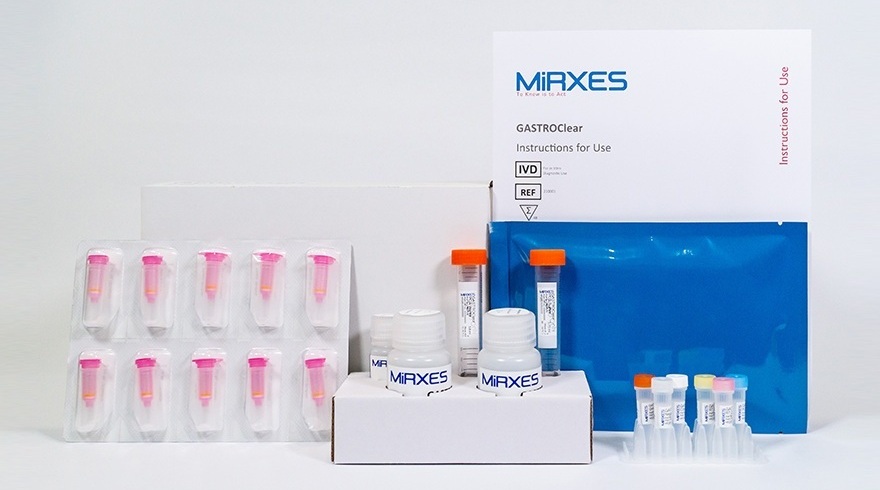
First Of Its Kind Blood Test Detects Gastric Cancer in Asymptomatic Patients
Each year, over 1 million people worldwide are diagnosed with gastric (stomach) cancer, and over 800,000 people die of the disease. It is among the top 5 deadliest cancers worldwide for both men and women.... Read moreHematology
view channel
Platelet Activity Blood Test in Middle Age Could Identify Early Alzheimer’s Risk
Early detection of Alzheimer’s disease remains one of the biggest unmet needs in neurology, particularly because the biological changes underlying the disorder begin decades before memory symptoms appear.... Read more
Microvesicles Measurement Could Detect Vascular Injury in Sickle Cell Disease Patients
Assessing disease severity in sickle cell disease (SCD) remains challenging, especially when trying to predict hemolysis, vascular injury, and risk of complications such as vaso-occlusive crises.... Read more
ADLM’s New Coagulation Testing Guidance to Improve Care for Patients on Blood Thinners
Direct oral anticoagulants (DOACs) are one of the most common types of blood thinners. Patients take them to prevent a host of complications that could arise from blood clotting, including stroke, deep... Read moreImmunology
view channel
Gene Signature Test Predicts Response to Key Breast Cancer Treatment
DK4/6 inhibitors paired with hormone therapy have become a cornerstone treatment for advanced HR+/HER2– breast cancer, slowing tumor growth by blocking key proteins that drive cell division.... Read more
Chip Captures Cancer Cells from Blood to Help Select Right Breast Cancer Treatment
Ductal carcinoma in situ (DCIS) accounts for about a quarter of all breast cancer cases and generally carries a good prognosis. This non-invasive form of the disease may or may not become life-threatening.... Read moreMicrobiology
view channel
Rapid Assay Identifies Bloodstream Infection Pathogens Directly from Patient Samples
Bloodstream infections in sepsis progress quickly and demand rapid, precise diagnosis. Current blood-culture methods often take one to five days to identify the pathogen, leaving clinicians to treat blindly... Read more
Blood-Based Molecular Signatures to Enable Rapid EPTB Diagnosis
Extrapulmonary tuberculosis (EPTB) remains difficult to diagnose and treat because it spreads beyond the lungs and lacks easily accessible biomarkers. Despite TB infecting 10 million people yearly, the... Read more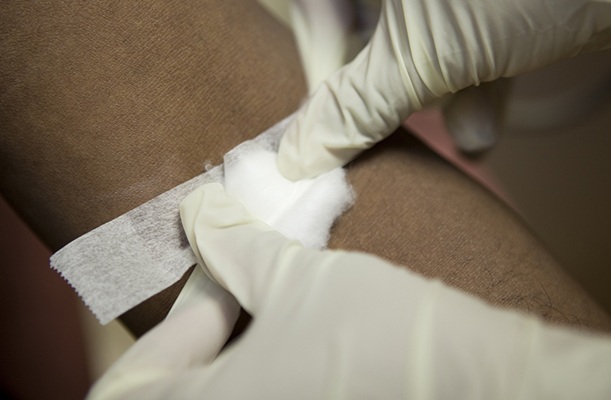
15-Minute Blood Test Diagnoses Life-Threatening Infections in Children
Distinguishing minor childhood illnesses from potentially life-threatening infections such as sepsis or meningitis remains a major challenge in emergency care. Traditional tests can take hours, leaving... Read more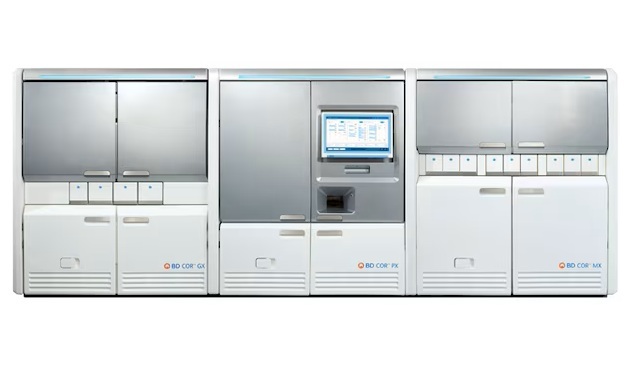
High-Throughput Enteric Panels Detect Multiple GI Bacterial Infections from Single Stool Swab Sample
Gastrointestinal (GI) infections are among the most common causes of illness worldwide, leading to over 1.7 million deaths annually and placing a heavy burden on healthcare systems. Conventional diagnostic... Read morePathology
view channel
AI Tool Rapidly Analyzes Complex Cancer Images for Personalized Treatment
Complex digital biopsy images that typically take an expert pathologist up to 20 minutes to assess can now be analyzed in about one minute using a new artificial intelligence (AI) tool. The technology... Read more
Diagnostic Technology Performs Rapid Biofluid Analysis Using Single Droplet
Diagnosing disease typically requires milliliters of blood drawn at clinics, depending on needles, laboratory infrastructure, and trained personnel. This process is often painful, resource-intensive, and... Read moreTechnology
view channel
AI Saliva Sensor Enables Early Detection of Head and Neck Cancer
Early detection of head and neck cancer remains difficult because the disease produces few or no symptoms in its earliest stages, and lesions often lie deep within the head or neck, where biopsy or endoscopy... Read more
AI-Powered Biosensor Technology to Enable Breath Test for Lung Cancer Detection
Detecting lung cancer early remains one of the biggest challenges in oncology, largely because current tools are invasive, expensive, or unable to identify the disease in its earliest phases.... Read moreIndustry
view channel
Abbott Acquires Cancer-Screening Company Exact Sciences
Abbott (Abbott Park, IL, USA) has entered into a definitive agreement to acquire Exact Sciences (Madison, WI, USA), enabling it to enter and lead in fast-growing cancer diagnostics segments.... Read more



















